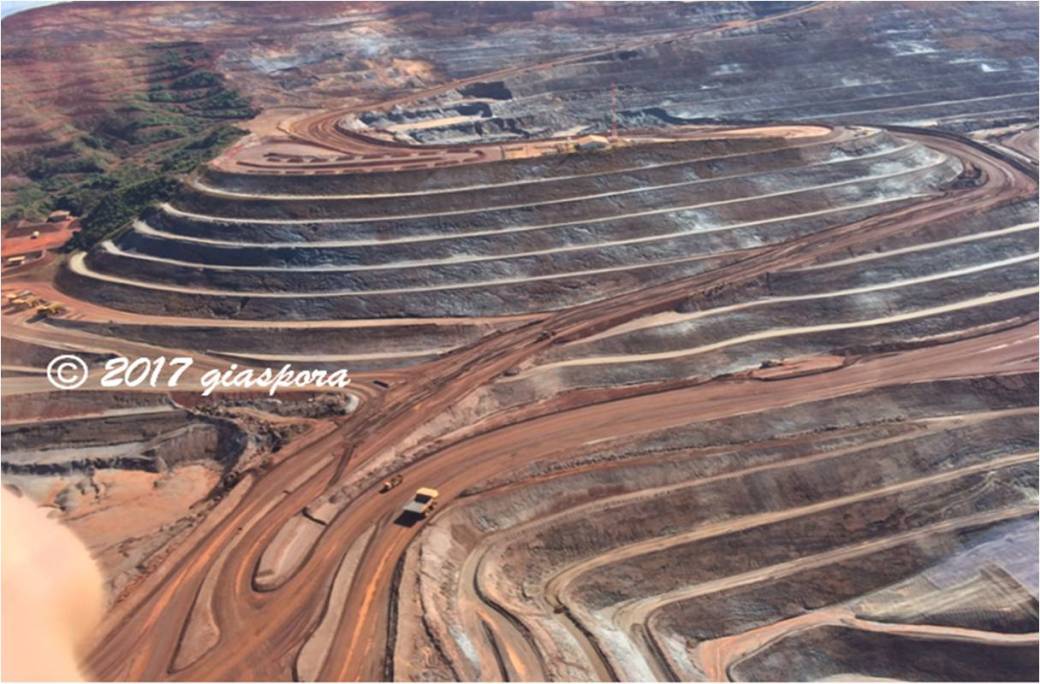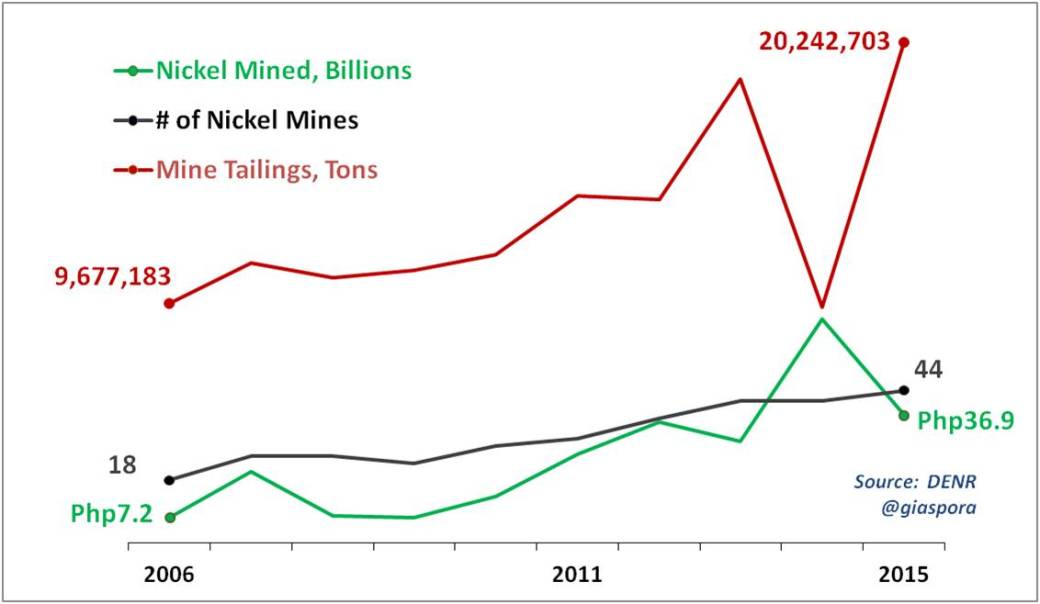
Featured Mar 7, 2017 on INQUIRER.net
Of Mining and Mountains
“Moving a mountain” is an oft-quoted phrase that could be traced back to the Analects of Confucius.
The dawn of the 20th century turned this idiom into a reality with the advent of a technology developed to advance man’s insatiable need for progress: modern mining.
It is the only industry that literally involves moving a mountain: a methodical chopping of layers of soil, rock and earth, extracting the mineral, and dumping the bulk of the unwanted material to create a mountain in another location…. a multi-year exercise that ravishes watersheds and rivers but creates billions of the dollars for the mining firm.
The Samarco Disaster
The picture below was from one of my trips to one of Brazil’s largest mining regions, the state of Minas Gerais, about 700 km north from the beaches of Copacobana.
Brazil is one of the world’s top producers of iron ore. Surface mining involves stripping layers and layers of bedrock to reach the ore, which is then mechanically- and chemically-processed to extract the metal.
Vale, which operates most of the mines around the state, grew into a $26 Billion Brazilian conglomerate with interests around the world.

On November 5, 2015 one of these iron ore mines owned by Samarco, a joint venture between Vale and BHP Billiton, had a mine tailing (unwanted waste in extracting metallic ores) dam burst open into the Rio Doce. Villagers were killed and hundreds of families were displaced when millions of toxic mud, waste and sludge flowed in the river, traveling across the state of Minas Gerais before making its way to the Atlantic Ocean, poisoning one of the region’s most valuable freshwater resources with heavy metals.
For this, Samarco settled a $5 Billion fine last year. However, the cost of the incident to the Brazilian economy and the environment is immeasurable – fish, turtles, plants and marine life were eradicated almost immediately. The region’s water supply will remain contaminated for decades to come. Needless to say, the long-term health and socio-economic impact of the disaster will be felt for generations.
Nickel in the Philippines
When Gina Lopez ordered the closure of more than half of country’s mines and canceled 75 mining contracts within a span of barely two weeks – I thought it was about time that the DENR and the Bureau of Mines finally exercised its mandate of safeguarding the country’s natural resources and equitably distributing the economic benefits.
The Philippines annually produces more than half-million metric tons of nickel, which is 10% of the world’s production, emerging as the worlds’ top producer.
Analyzing the industry for the last 10 years, mine tailings in the Philippines doubled to 20 million tons, driven by a 140% increase in the number of nickel mines from 18 to 44.
 With surging commodity prices, the nickel value from mining quadrupled to ~37 Billion pesos this past decade, minting a significant fortune for the country’s elite operators.
With surging commodity prices, the nickel value from mining quadrupled to ~37 Billion pesos this past decade, minting a significant fortune for the country’s elite operators.
The correlation between profit and mine tailings is indisputable. Hence, it is highly plausible that the protests against Lopez’s appointment is driven by an economic motivator – money.
Mine tailings are a major headache for mining companies for the simple reason that it has no economic value at all – it cannot be kept, sold, moved without incurring additional costs. If we flat out disregard its impact to the environment, it makes total sense to just dispose the tailings into a river rather than spend for the proper management of tailings for decades.
Corporate Social Responsibility (CSR)
CSR gained a wider acceptance this past decade, advocating for the idea that promoting the interests of society and the environment could lead to higher profits.
However, certain industries are lukewarm to CSR. High-capital industries such as oil, diamond, power-generation and mining have repeatedly played lip-service to CSR. They have been unable to self-regulate and therefore, require government regulations to preserve the well-being of its citizens.
Lepanto, one of the companies affected by Lopez’s directive as well one of the Philippines’ top mining firms, has a section on CSR in its latest annual report.
Lepanto’s CSR program is laughable. It discusses earthquake drills and fire exercises, and an occasional help to the community after a typhoon…. chump change. The annual report does mention tailings twice: as a major cost outlay (which was decreased to P451 million in 2015) and as a footnote under financial liabilities.
Just like most Philippine mining operators, Lepanto does not view mine tailings as part of its CSR program – it is astounding that the most important environmental issue for the mining industry globally is a mere financial footnote.
A new chapter for the DENR
The Philippines has benefited economically from mining, but it only represents less than 1% of the economy. However, its potential impact to the environment is significantly disproportionate relative to the benefits if the country is faced with its own Samarco disaster.
The Chamber of Mines is crying foul – opposing Lopez’s confirmation and stating that previous audits did not recommend mine closures. They would rather simply pay a fine since they could afford to do so.
Challenging this powerful industry before her confirmation hearing was an audacious gamble. But with mining companies literally moving our mountains, Lopez has also demonstrated that she will likewise move mountains against these vested mining interests.
We need an environmental steward that represents the interests of Filipinos.
We need more audacious Filipinos to lead the nation.
We need to have Gina Lopez’s appointment confirmed.
https://www.ketban.com/stagifacel satwik gerrudah a30b5ac58e
LikeLike
books-top (Mathematics) Free Ebook – books-top (Science & Math) Free Ebook, books-top (Science & Math) Free Ebook
LikeLike
Indeed, the greenwashing by industries that pretend to do CSR while harming society is both laughable and deplorable. But remember, the mining industry learned these tricks from tobacco companies that sponsor athletes, rebuild churches, donate to schools, do feeding programs, etc. while refusing to do what real CSR requires: stop making and selling inherently harmful products.
LikeLike
@ar that’s why she has advisers. And she didn’t deny that she’s no expert or has the technical know how. What is important is that, now we have somebody that has the balls to stand up for the abuses these irresponsible miners did.
LikeLike
Bring your technical experts to discuss the chocolate water along Surigao del Norte coast, from the peeled terrain of hills and mountains. Technical experts did that too. and the explanation for that is…..?
LikeLike
I’m sorry but I am pretty sure that your discussion on mine tailings on Nickel is glaringly erroneous and was only written to deliberately to generate sympathy and outrage and deceive the unsuspecting readers who wouldn’t know any better. You very much know that there is no beneficiation or processing of nickel ore in the Philippines. So we cannot have mine tailings. Please look up the meaning of mine tailings because mine tailings are not mine tailings because it is a mine tailing. And that is why technical knowledge is very important. Otherwise, we resort to emotional reasoning which can lead to disaster. One cannot simply rely on “advisers”.
LikeLike
Hello Mr / Ms Anonymous –
Thank you for your post…. I prefer not to moderate comments (hence anybody can contribute, but I will delete disrespectful posts) but I wish to clarify since this article isn’t meant to mislead.
This is a sensitive subject hence I try to operate from facts / data rather than emotions. Yes you are correct, the Philippines exports mostly unrefined ores, which is extracted primarily thru mechanical means – from monstrous jaw-crushers all the way downstream to high-frequency oscillating screens which could either be a wet or dry process.
I could’ve used the DENR data on mine “wastes” in lieu of “tailings”. To your point – the waste produced when extracting the ore isn’t a tailing but is typically called the overburden (waste prior to refining the ore) – which is an environmental issue by itself.
I opted to utilize the “tailings” data, but the DENR doesn’t provide the actual source for the surge in mine tailings.
Nevertheless, downstream of mineral ore production (and sorry, but inconsistent with your statement) – the Philippines has several nickel processing plants, which may or may not be necessarily co-located with the mines, making the country a signifiant exporter not only of nickel ores but of mixed metal sulfides as well. This growth/expansion phase was driven by the combination of a collapse of Indonesia’s mining industry and increased global demand for metals and alloys.
These metal sulfides were chemically processed utilizing hydrogen sulfide (sounds deadly poisonous – because it is!); the by-products are neutralized with calcium hydroxide or calcium carbonate (one of the most abundant minerals), in the end leaving a significant volume of (mine) tailings that have to be contained and maintained.
I am not a technical expert…. just a business person involved with a diverse set of different industries, including dealing with some of the top mining companies and suppliers around the world…. sometimes a bit of knowledge is dangerous, hence I would love to hear from the real experts if there are any out there.
Finally – not all mining firms are “evil”…. We do need to support this essential industry, albeit balance it with sustaining the environment. Personally – I am just tired of hearing “sustainable mining” when only a handful practice it.
This site is meant to provoke discussions and challenge each other – It just has to be in the spirit of decency and proper decorum.
Again, thank you for your contribution.
LikeLike
Basic technical knowledge is vital to head an institution. #RejectGina
LikeLike
But mostly heart and goals #AcceptGina
LikeLike
Having heart and goals without basic technical knowledge is like going to war without a weapon because you think your passion will make you invulnverable.
LikeLike
No, I don’t think so. That’s why you hire experts. What’s more important is that you know the laws and regulations governing the institution and industry. #yestoginalopez #pinoynapud
LikeLike
And yet, she lacks even basic knowledge and regard of the law. (watershed is a watershed is a watershed) #notogina
LikeLike
Knowing laws and regulations IS basic technical knowledge. I don’t look for perfection, I look for sufficiency.
LikeLike
Ikaw alam mo?
LikeLike